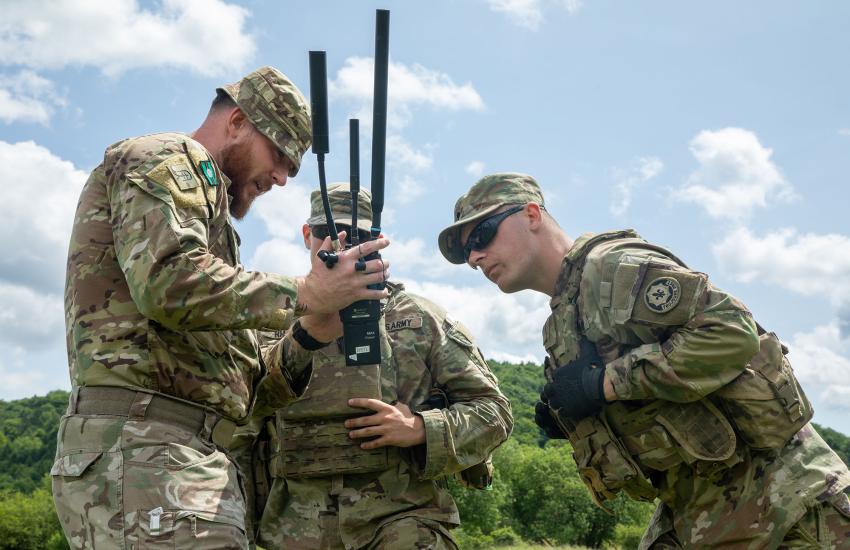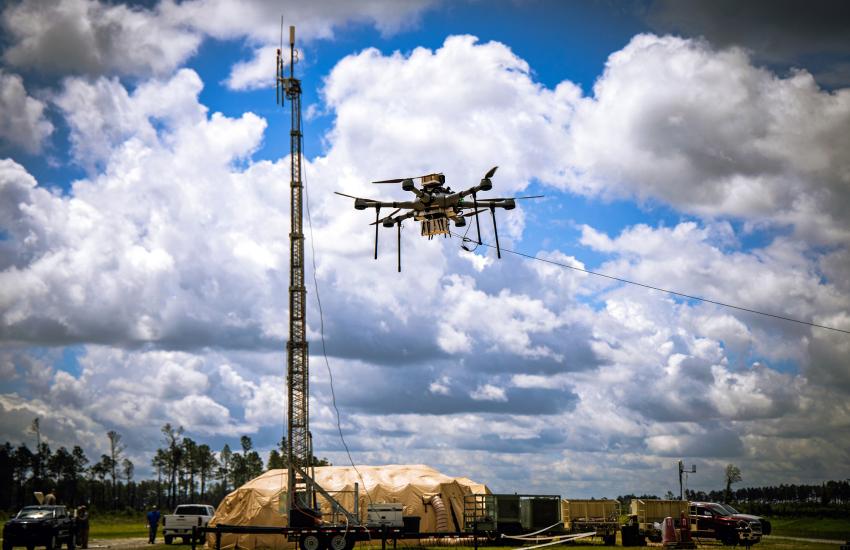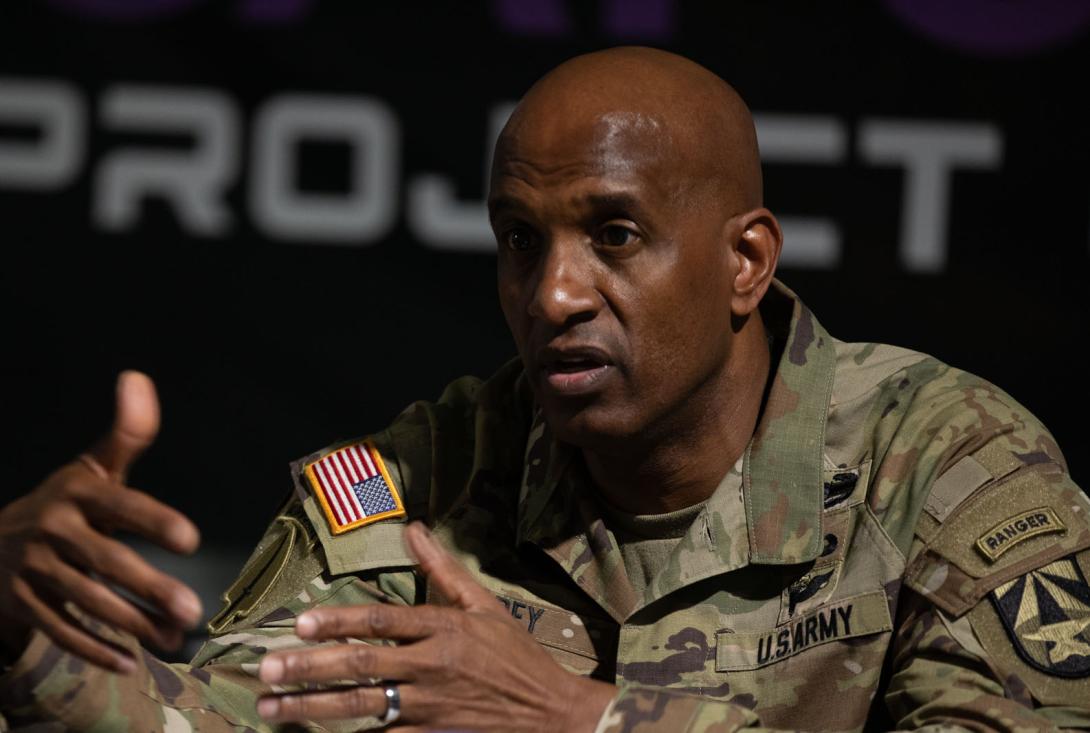U.S. Army Building Global IT Warfighting Platform To Prepare for Cyber Warfare
The next war to embroil the U.S. Army may be launched with cyber attacks rather than with bombs and bullets. To prepare for that possibility, Lt. Gen. Jeth Rey, the U.S. Army’s deputy chief of staff, G-6, conducted a 100-day assessment of C4 capabilities and systems and established five focus areas as a result: optimizing the Signal Corps, cyber and electronic warfare workforce; accelerating the transport and the infrastructure portion of Next Generation Command and Control, reimagining the mission partner environment, enhancing electronic warfare spectrum awareness for commanders and optimizing operational technologies.
“Most people think that the war is over there. I believe it’s over here, lurking in our networks, 24 by seven. The next war may not be a kinetic strike, but rather a cyber event that could potentially disrupt us in a way that we’ve never been disrupted before,” Rey told SIGNAL Media in an exclusive interview. “What we think about every day is transitioning from what we believed the Unified Network was going to be into this global IT warfighting platform. It’s from end to end, from the tactical to the enterprise on this global scale, because we’re incorporating things like next-generation command and control onto this global IT warfighting platform.”
The results of the review were presented to the Army’s senior leadership in mid-June, and Rey indicated he may be able to publicly provide more details this summer, potentially at AFCEA International’s TechNet Augusta conference in Augusta, Georgia, August 18-21.
Rey’s team is working with others, including: Army Futures Command, which is largely responsible for the service’s modernization efforts, including network modernization; Army Cyber Command (ARCYBER), which integrates and conducts cyberspace operations, electromagnetic warfare and information operations; and Network Enterprise Technology Command (NETCOM), an ARCYBER subcommand that plans, engineers, installs, integrates, protects and operates the service’s cyberspace.
“We have to protect and defend that [global IT warfighting network] end to end. That’s NETCOM’s and ARCYBER’s role and responsibility right now. And so, if we can get there sooner rather than later, where we can see the network in the end and protect it, we might be able to defend against that potential cyber attack.”
The general recommends accelerating development of the architecture and data transport for the service’s Unified Network, a strategic initiative to merge tactical, warfighting networks and enterprise networks.
Earlier this year, the service released its Unified Network Plan 2.0, which focuses primarily on phase 2 and some of phase 3 that calls for operationalizing the network into 2026 and to modernize and transform the network in 2027 and beyond.
The 100-day assessment included visits to combatant commands, Army service component commands, subcommands and Army training sites. It indicated a need for workforce transformation. “We’re looking at workforce optimization, so you will see that transform.”
ARCYBER and the Army Cyber Center of Excellence focus on electronic warfare as well as signal and cyber, and workforce modernization will focus on all three, he indicated. Rey compared the network to a football field and pointed out that all need to be able to play. “All of our data transitions that network. Offensive cyber transitions it; defensive cyber protects it; electronic warfare transitions it; signal installs, operates and maintains it. And you know that the intel data also transits to the network.”
Asked what obstacles need to be overcome to reach the Army’s goals, he indicated that defensive cyber operators need to be able to act more quickly, which new technologies may enable. “One [focus] is to relook [at] our workforce to ensure that they are trained and ready and understanding the use of data and how to protect the network from a cybersecurity perspective and defend it. That’s going to be key for us. We have offensive cyber, but our defenders must be there sooner to protect us. I believe that artificial intelligence, machine learning and leveraging cloud will give us some more resiliency within the network boundaries.”
Although cyber, electronic warfare, signal and intelligence military occupational skills are closely related, Rey said he does not foresee a future in which the different career fields converge. “When you say converge, it sounds like we’re actually developing an organization that has all these units in it. We’re not there yet. I think the conversation is being discussed, but I’m not sure we’re there. All four entities still need to work together. They must work hand in hand in order to achieve lethality.”
He will also focus on accelerating data transport capabilities and the architecture required for Next-Generation Command and Control. “When next-gen C2 comes along ... could we accelerate the transport and the infrastructure early before the data layer and the application layer arrive? We’re working closely with Army Futures Command and all stakeholders in developing a plan to accelerate the transport and to accelerate the infrastructure portion of next-generation command and control.”
The Army’s transition to become a data-centric force requires reliable and efficient data movement across the entire network with a focus on getting the right data to the right place, at the right time, securely and reliably. To that end, the service is working with the Defense Information Systems Agency (DISA) on zero trust and identity, credential and access management capabilities, which will be crucial to achieve data security by 2027. “Achieving zero trust in getting our identity, our credential and access management achieved for the entire Department of Defense will protect us. Those are some things that we’re working on currently in order to get there sooner rather than later.”
The 100-day assessment offered other insights, including the need for commanders to visualize their electromagnetic spectrum footprint, the need to unite operational technologies on the battlefield and information technologies on the enterprise, and the need to rethink the mission partner environment. “We’re also reimagining the mission partner environment. Now that DISA has been asked to take a harder look at how we can make it a persistent environment, we’re going to work closely with DISA as soon to be, hopefully, the executive agent for mission partner environment,” he offered.
The C4 director said officials are reforming policies to allow international partners to more easily access the mission partner environment at lower classification levels. “Policy changes have to happen, and we’re working closely with DISA and the joint staff on all types of policy changes to bring our partners in early. It’s a policy issue, and all policies can be adjusted in order to meet us early in the process.”
Rey also stressed the importance of the Army reactivating the 25th Infantry Division’s 125th Signal Battalion in April and plans to reactivate nine additional battalions, with signal battalions under the 82nd Airborne Division and the 101st Airborne Division being next in line. The signal battalions were deactivated when brigade combat teams were organized as part of the Army’s transformation to a modular force. Now, they are being reactivated as part of the service’s Transforming in Contact initiative, which focuses on integrating new technologies into operational units while gathering feedback in real time, according to an Army announcement.
“The senior leadership of the Army approved the division signal battalions to stand back up. That’s a huge accomplishment, something we’ve been working on for over a decade. The 125th Signal Battalion has been stood up as the first provisional signal battalion, and there will be nine additional signal battalions to join them,” he said.

The reactivations are necessary in part to enable mobile command posts. “As we moved complexity up from the brigade combat teams to the division environment, it was important to bring the skills and attributes with it in order to continue to provide services to all the [subordinate] units. “As we continue to have maneuverable command posts—we don’t have stationary command posts anymore—now we have command posts that are on the move. And these teams, these 32 teams that are attached to that signal battalion will support those command posts at all their [subordinate] units.”
The divisions and their reactivated signal battalions will receive new equipment, including Integrated Tactical Network capabilities, proliferated low-Earth orbit satellite communications terminals and new and improved baseband equipment for increased mobility.
Rey tied the 100-day review and its results to the Army Transformation Initiative (ATI) prompted by Secretary of Defense Pete Hegseth’s April 30 memorandum calling for Army transformation and acquisition reform. “To build a leaner, more lethal force, the Army must transform at an accelerated pace by divesting outdated, redundant, and inefficient programs, as well as restructuring headquarters and acquisition systems. Simultaneously, the Army must prioritize investments in accordance with the administration’s strategy, ensuring existing resources are prioritized to improve long-range precision fires, air and missile defense, including through the Golden Dome for America, cyber, electronic warfare, and counter-space capabilities,” Hegseth wrote.
Rey said the ATI increases lethality across the board, reduces bureaucracy and replaces legacy capabilities with newer, more commercial off-the-shelf technologies. “It’s an incredible initiative. The Army is breaking down bureaucracy, breaking down legacy capabilities and inserting new commercial systems in a continuous transformation,” he offered.







Comments